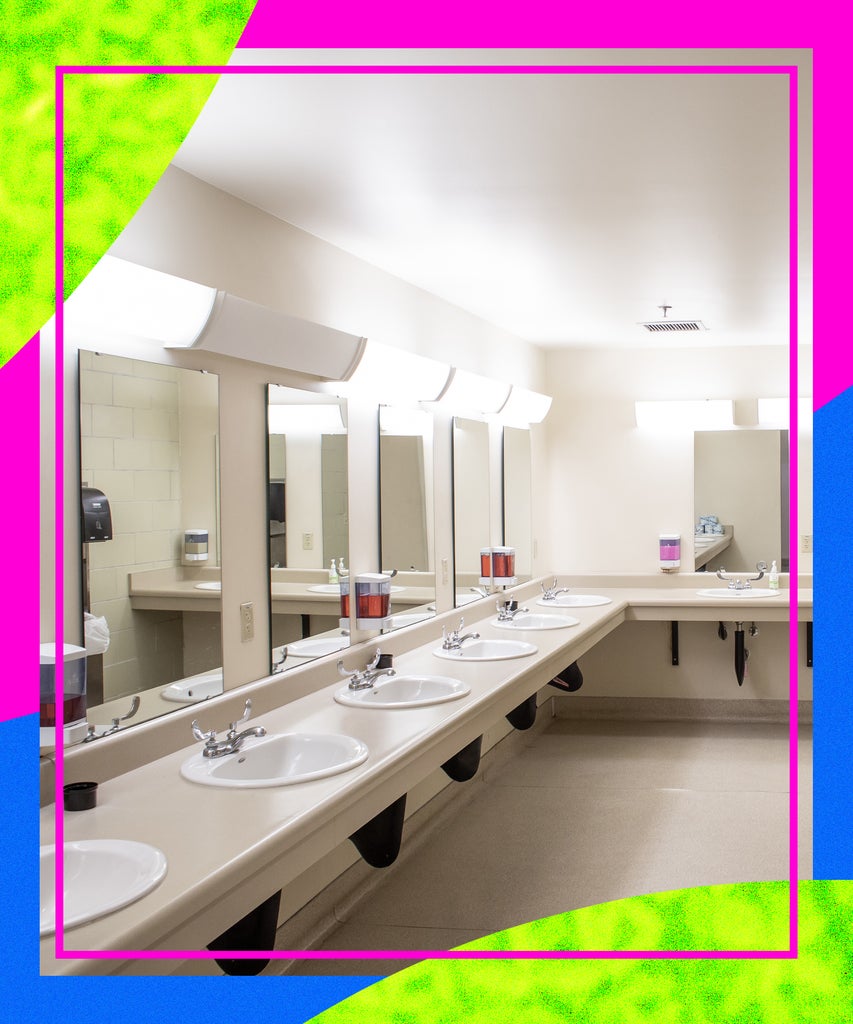
When I started college as a freshman, the hardest adjustment for me was sharing a bathroom. I’d always abhorred public restrooms. As a little girl, I walked into one at my local swimming pool and there was poop everywhere. I stepped in it. I gagged. Not long after, I walked home from school hunched over and near tears because I had to pee so badly, but I wouldn’t use my school’s toilets. Of course, I became more rational over the years. But the public potties in my college’s dorms still intimidated me. The thought of occasionally having to (gulp) wipe someone else’s sprinkles off the seat made me think about dropping out before I even started. And that was during a normal school year.
But the public restrooms in dorms in 2020 present more risks than just having to listen to your roommate drop some heat. “The primary concern with shared dorm bathrooms is that no one will be wearing masks, since they are showering, brushing teeth, and washing faces,” explains Jill Grimes, MD, author of The Ultimate College Student Health Handbook. Because COVID-19 is most often transmitted through respiratory droplets, this could lead to more cases on campus, she says.
Another reason the lavs are a potential hotspot: They have more wet surfaces and steam. Some research shows that the virus may live longer where it’s moist and humid, Dr. Grimes adds. Surfaces are another concern, although they’re not the main way COVID-19 spreads. “If you were going to see transmission from surface contamination — by you touching something then touching your mouth, say — this would be one of the most likely places,” Dr. Grimes notes.
Because of these issues, we’ve asked experts to weigh in with their best tips for avoiding catching COVID in the loo.
Mask up
Unless you’re brushing your teeth or showering, try to keep your face mask tethered to your ears. When you do have to take off the covering, try to do so when others aren’t around. In fact, Dr. Grimes says it’s generally a good idea to try to find times when the bathrooms are empty or not crowded.
But as they say: When you gotta go, you gotta go. If you can’t avoid others, socially distance. Hit a sink or seat a few rows down from the next student. “Space yourself apart if you’re waiting for the shower, or go back later if possible,” Dr. Grimes adds. “Many campuses are using scheduled community bathroom times to minimize this.”
Wash your hands (more)
You’ve heard it a thousand times, but we’ll say it again. Wash your hands after you do your business — and in the age of COVID, also after you touch things like door or shower handles. If you need to wash your face, but just touched the sink, scrub again or use hand sanitizer, just to be safe. “Do it for the full 20 seconds — don’t go back to the ‘splash ’n dash’ technique many of us had pre-COVID,” Dr. Grimes says.
Another thing to remember: You might want to use hand sanitizer when you get back to your room if you touch the bathroom door handle on the way out, suggests Erika Schwartz, an internist and the founder of ES Health, a Manhattan concierge medical practice.
Think about trouble spots
Consider the most commonly touched areas in lavatories, Dr. Schwartz says. A lot of people are going to be putting their paws all over the toilet handles and the locks on the stalls, so consider bringing a Clorox or alcohol-based wipe with you so you can give them a swab before use. You can also use your foot to flush. If your school’s commode has a lid, close it before flushing, she adds. A growing body of evidence shows that the virus could be passed through feces, and one study found that flushing the toilet bowl essentially could fling COVID-19 aerosols everywhere putting you more at risk.
Your shower caddy is your friend
Using a tote or caboodle for your toiletries is recommended even by the Centers for Prevention and Disease Control in their shared housing policies. It will help keep your stuff away from shared surfaces. So definitely get a shower caddy for your shampoo and conditioner, and be especially diligent to avoid put your toothbrush down on the sink. “If [someone infected] brushes their teeth, then sets their dripping wet toothbrush down on the sink, then you follow behind them and put your toothbrush on the sink before you put it in your mouth, their wet respiratory secretions get on your toothbrush.” That could mean infection.
If you have to place something like a hairbrush or your moisturizer on a shared surface, place a paper towel down under it or cleanse the area first with a wipe or sanitizer, Dr. Schwartz suggests.
Don’t bring your phone
Okay, so, I too am guilty of scrolling through TikTok or Twitter on the toilet, just to keep myself occupied. But it’s not a good idea right now. “So many people sit inside the stall, playing games or checking social media or emails,” Dr. Grimes says. “This is prolonging your exposure in a poorly ventilated, highly trafficked area, thus increasing your COVID risk. Not to mention you’re not typically sanitizing your phone when you leave the stall, so washing your hands and then grabbing your dirty phone is not good hygiene.”
Like what you see? How about some more R29 goodness, right here?
Is It Safe To Get Your Brows Done During COVID-19?
Feel Good Diary: College & Coronavirus
Thousands Of COVID-Positive Students Threw A Party
from Refinery29 https://ift.tt/2Zx4JPh
via IFTTT
